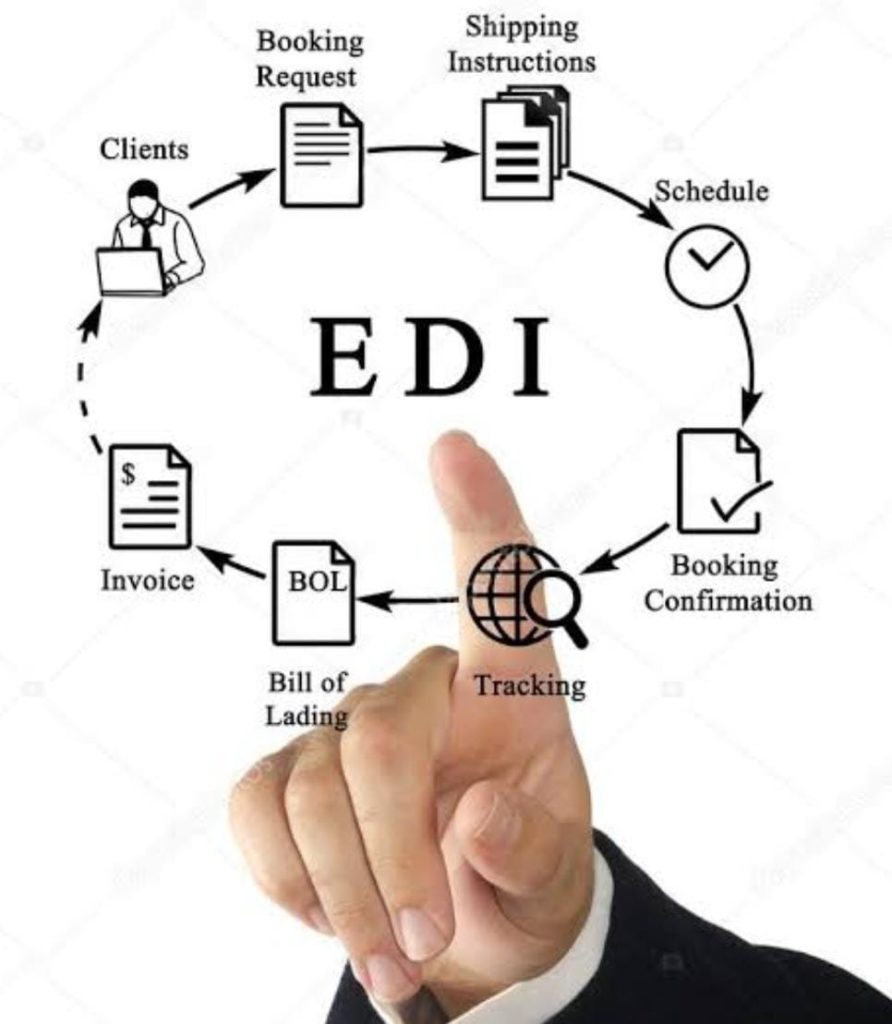Electronic Data Interchange (EDI) is a computer-to-computer exchange of business documents and information between trading partners in a standardized electronic format. It enables the seamless transfer of data such as purchase orders, invoices, shipping notices, and other transactional documents, eliminating the need for paper-based processes and manual data entry.
Table of Contents
EDI operates through a series of steps: data creation, translation, transmission, receipt, translation, and integration with internal systems. Organizations use specialized EDI translation software to convert electronic documents from one format to another, ensuring seamless communication between disparate systems and trading partners. Communication protocols such as FTP, AS2, SFTP, and VANs facilitate the secure exchange of EDI messages over the internet or private networks, providing encryption, authentication, and data integrity mechanisms to safeguard sensitive information.
The benefits of EDI are manifold. By automating and standardizing business processes, EDI streamlines supply chain operations, reduces manual errors, and accelerates transaction processing times. It enhances visibility, efficiency, and collaboration across the entire supply chain, enabling organizations to respond quickly to changing market demands and customer needs.
Overall, EDI plays a critical role in modern commerce, enabling businesses to improve productivity, reduce costs, and enhance competitiveness in a global marketplace. As technology continues to evolve, EDI remains an essential tool for facilitating seamless integration and interoperability in electronic transactions and supply chain management.
What is an EDI Model?
The Electronic Data Interchange (EDI) model is a framework for exchanging business documents and information electronically between different computer systems and entities within organizations, across industries, and among trading partners. The EDI model facilitates the seamless transfer of standardized data formats, such as purchase orders, invoices, shipping notices, and payments, without the need for manual intervention or paper-based documentation.
The EDI model consists of several key components:
Data Formats: EDI relies on standardized data formats or message standards, such as ANSI X12, EDIFACT, and XML, to define the structure and content of electronic documents. These formats specify the layout, data elements, and coding conventions for different types of business transactions, ensuring compatibility and consistency between trading partners’ systems.
Communication Protocols: EDI requires reliable communication protocols to transmit data securely and efficiently between sender and receiver systems. Common communication protocols used in EDI include FTP (File Transfer Protocol), AS2 (Applicability Statement 2), SFTP (SSH File Transfer Protocol), and VANs (Value-Added Networks). These protocols provide encryption, authentication, and data integrity mechanisms to safeguard sensitive information during transmission.
Translation Software: EDI translation software is used to convert electronic documents from one format to another, ensuring compatibility between different systems and standards. Translation software performs functions such as parsing, validation, mapping, and transformation of EDI messages, allowing organizations to send and receive data seamlessly across disparate systems and platforms.
Data Mapping and Integration: EDI systems often include tools for data mapping and integration, allowing organizations to map data elements from their internal systems to the standardized formats required for EDI transactions. This enables seamless integration between EDI systems and back-office applications, such as enterprise resource planning (ERP) systems, inventory management systems, and accounting software.
Security and Compliance: Security and compliance are critical considerations in EDI implementations. Organizations must adhere to industry-specific regulations and standards governing data privacy, security, and electronic transactions. EDI systems employ encryption, digital signatures, and secure communication protocols to protect sensitive information and ensure regulatory compliance.
Overall, the EDI model provides a standardized framework for electronic data interchange, enabling organizations to automate business processes, streamline supply chain operations, and enhance collaboration with trading partners. By leveraging EDI technology, businesses can improve efficiency, reduce costs, and accelerate transaction processing times, ultimately driving greater productivity and competitiveness in the digital marketplace.
EDI Documents
Electronic Data Interchange (EDI) involves the exchange of various types of business documents and transactions between trading partners in a standardized electronic format. These documents represent the core elements of EDI transactions and are essential for facilitating seamless communication and collaboration across supply chains and business networks. Some of the most common EDI documents include:
Purchase Orders (850): Purchase orders are documents sent by buyers to suppliers to request the purchase of goods or services. The EDI 850 Purchase Order typically includes information such as item descriptions, quantities, prices, delivery dates, and payment terms.
Invoices (810): Invoices are documents sent by suppliers to buyers to request payment for goods or services rendered. The EDI 810 Invoice includes details such as invoice number, billing address, payment terms, line item descriptions, quantities, prices, and total amounts.
Advance Ship Notices (856): Advance Ship Notices (ASNs) are documents sent by suppliers to buyers to provide advance notification of shipments. The EDI 856 ASN contains information about the contents of the shipment, including item details, quantities, packaging information, carrier details, and expected delivery dates.
Functional Acknowledgments (997): Functional Acknowledgments are documents sent by the receiving party to acknowledge the receipt and processing of EDI transactions. The EDI 997 Functional Acknowledgment confirms whether the transmission was successfully received, processed, and accepted or rejected based on validation criteria.
Request for Quote (840): Request for Quote documents are sent by buyers to suppliers to request pricing and availability information for specific products or services. The EDI 840 Request for Quote includes details such as item descriptions, quantities, pricing, delivery terms, and contact information.
Remittance Advice (820): Remittance Advice documents are sent by buyers to suppliers to provide payment details for invoices. The EDI 820 Remittance Advice includes information such as invoice numbers, payment amounts, payment dates, and banking information.
Product Catalogs (832): Product Catalogs are documents sent by suppliers to buyers to provide information about available products and services. The EDI 832 Product Catalog includes details such as product descriptions, pricing, availability, and specifications.
These are just a few examples of the many types of EDI documents used in electronic transactions. Each document serves a specific purpose and contains standardized data elements that enable seamless communication, automation, and integration between trading partners’ systems. By exchanging EDI documents, organizations can streamline business processes, reduce errors, improve efficiency, and enhance collaboration across the supply chain.
EDI Users
Electronic Data Interchange (EDI) users include a wide range of entities across various industries and sectors. These users leverage EDI technology to streamline business processes, automate transactions, and facilitate seamless communication and collaboration with trading partners. Some of the key EDI users include:
Retailers and Suppliers: Retailers and suppliers in industries such as retail, consumer goods, and manufacturing are among the primary users of EDI. Retailers use EDI to send purchase orders, receive invoices, manage inventory, and track shipments from suppliers. Suppliers, on the other hand, use EDI to process orders, send invoices, provide advance shipment notices, and manage logistics.
Automotive Manufacturers and Suppliers: In the automotive industry, manufacturers, suppliers, and distributors rely on EDI to coordinate production schedules, manage inventory levels, and facilitate just-in-time (JIT) delivery of parts and components. EDI enables seamless integration and communication between automotive OEMs (Original Equipment Manufacturers) and their suppliers, ensuring efficient supply chain management.
Healthcare Providers and Payers: In the healthcare industry, providers, payers, and clearinghouses use EDI to exchange claims, remittance advice, eligibility verification, and other administrative transactions electronically. EDI streamlines healthcare billing processes, reduces paperwork, and accelerates reimbursement cycles for healthcare providers and insurers.
Financial Institutions: Financial institutions, including banks, credit unions, and financial services providers, use EDI to facilitate electronic fund transfers, wire transfers, electronic payments, and other financial transactions securely. EDI enables banks to exchange payment instructions, reconcile accounts, and manage electronic banking services for corporate clients and consumers.
Government Agencies: Government agencies at the local, state, and federal levels use EDI to streamline procurement processes, manage vendor relationships, and facilitate electronic payments and invoicing. EDI enables government entities to automate purchasing, bidding, and contract management activities, improving efficiency and transparency in public sector operations.
Transportation and Logistics Companies: Transportation carriers, logistics providers, and freight forwarders rely on EDI to manage shipment orders, track freight movements, and exchange shipping documents electronically with customers, suppliers, and partners. EDI streamlines freight booking, dispatching, and tracking processes, reducing administrative overhead and improving visibility across the supply chain.
Trading Partners and Supply Chain Partners: Beyond specific industries, trading partners and supply chain partners across diverse sectors use EDI to collaborate, exchange information, and conduct business transactions electronically. EDI fosters seamless integration and interoperability between trading partners’ systems, enabling efficient supply chain management, inventory control, and order fulfillment.
Overall, EDI users span a broad spectrum of industries, organizations, and business functions, all of which benefit from the efficiency, accuracy, and cost-effectiveness of electronic data interchange in conducting business transactions and managing relationships with trading partners.



